利用者:ロイヤルオーク/sandbox/下書き5
The United Nations Educational, Scientific and Cultural Organization (UNESCO) World Heritage Sites are places of importance to cultural or natural heritage as described in the UNESCO World Heritage Convention, established in 1972.[1] Austria ratified the convention on December 18, 1992, making its historical sites eligible for inclusion on the list.[2]
Sites in Austria were first inscribed on the list at the 20th Session of the World Heritage Committee, held in Mérida, Mexico in 1996. At that session, two sites were added: the Historic Centre of Salzburg, and the Palace and Gardens of Schönbrunn.[3] Other sites were added each year until 2001 and again in 2011 and 2017. 2019年現在[update], Austria has 10 sites inscribed on the list and a further 12 on the tentative list. Three World Heritage Sites are shared with other countries: Fertö / Neusiedlersee Cultural Landscape is shared with Hungary; Prehistoric pile dwellings around the Alps with France, Germany, Italy, Slovenia and Switzerland; and Ancient and Primeval Beech Forests of the Carpathians and Other Regions of Europe with Albania, Belgium, Bulgaria, Croatia, Germany, Italy, Romania, Slovakia, Slovenia, Spain, and Ukraine. In 2017, the site Historic Centre of Vienna was inscribed on the list of World Heritage in Danger due to planned new high-rise buildings.[4] All but one of the World Heritage Sites in Austria are of the cultural type.[2]
World Heritage Sites
[編集]UNESCO lists sites under ten criteria; each entry must meet at least one of the criteria. Criteria i through vi are cultural, whereas vii through x are natural.[5]
| Site | Image | Location | Year listed | UNESCO data | Description |
|---|---|---|---|---|---|
| Historic Centre of the City of Salzburg | 
|
Salzburg | 1996 | 784; ii, iv, vi (cultural) | Salzburg played a crucial role in the interchange between Italian and German cultures, resulting in a flowering of the two cultures and a long-lasting exchange between them, which is visible especially in the Baroque architecture. Salzburg is a prime example of a European ecclesiastical city-state, resulting in many important buildings, both secular and religious, from the Gothic period to the 20th century. The city is also well known for its associations with the arts, especially with the composer Wolfgang Amadeus Mozart.[6][7] |
| Palace and Gardens of Schönbrunn | 
|
Vienna | 1996 | 786; i, iv (cultural) | Schönbrunn was the residence of the Habsburg emperors from the 18th century to 1918. It was built in the Rococo style as a single, unified project. It was designed by the architects Johann Bernhard Fischer von Erlach and Nicolaus Pacassi and is the site of the world's oldest continuously operating zoo.[8] |
| Hallstatt–Dachstein / Salzkammergut Cultural Landscape | 
|
Salzkammergut | 1997 | 806; iii, iv (cultural) | The mining of salt deposits, exploited since the 2nd millennium BCE, brought prosperity to the region. The town gave name to the Hallstatt culture, the Iron Age society. The region is also known for its mountain ranges and caves, the longest of the latter reaching a length of 81 km (50 mi).[9] |
| Semmering railway | 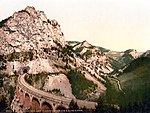
|
Gloggnitz, Semmering | 1998 | 785; ii, iv (cultural) | The Semmering railway was built between 1848 and 1854 and covers 41 km (25 mi) of rugged mountains. This project was undertaken in the early days of railway construction and required a number of innovations. The tunnels, viaducts and other works are still in use today.[10] |
| City of Graz – Historic Centre and Schloss Eggenberg | 
|
Graz | 1999 | 931; ii, iv (cultural) | A branch of the Habsburg family lived in Graz for centuries. The Habsburgs and other local nobles beautified and expanded Graz over centuries, leading to a city with grand buildings in a number of styles.[11] |
| Wachau Cultural Landscape | 
|
Wachau | 2000 | 970; ii, iv (cultural) | The Wachau is a 40 km (25 mi) long valley along the Danube river between Melk and Krems. The valley was settled in prehistoric times and has been an important region since then. It is home to a number of historic towns, villages, monasteries, castles and ruins.[12] |
| Fertö / Neusiedlersee Cultural Landscape* | 
|
Burgenland | 2001 | 772; v (cultural) | The Fertö/Neusiedler Lake area has been occupied by different peoples for eight millennia. The original network of towns and villages dates to the 12th and 13th centuries. Several palaces were constructed in the 18th and 19th centuries. The site is shared with Hungary.[13] |
| Historic Centre of Vienna |

|
Vienna | 2001 | 1033; ii, iv, vi (cultural) | Vienna, the capital of the Habsburg Empire, has long been acknowledged to be the musical capital of Europe. The historic centre is rich in architectural ensembles in various styles, including Baroque castles and gardens, as well as the late-19th-century Ringstraße.[14] In 2017, the site was inscribed on the list of World Heritage in Danger due to planned new high-rise buildings.[4][15] |
| Prehistoric pile dwellings around the Alps* | – | Attersee, Keutschach, Seewalchen am Attersee, Mondsee | 2011 | 1363; iv, v (cultural) | The site encompasses the remains of prehistoric pile-dwelling (or stilt house) settlements in and around the Alps built from around 5000 to 500 BCE on the edges of lakes, rivers or wetlands. They contain a wealth of information on life and trade in agrarian Neolithic and Bronze Age cultures in Alpine Europe. There are five sites listed in Austria.[16] The site is shared with France, Germany, Italy, Slovenia, and Switzerland.[17] |
| Ancient and Primeval Beech Forests of the Carpathians and Other Regions of Europe* | 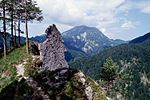
|
Dürrenstein, Kalkalpen | 2017 | 1133; ix (natural) | Primeval Beech Forests of the Carpathians are used to study the spread of the beech tree (Fagus sylvatica) in the Northern Hemisphere across a variety of environments and the environment in the forest. The site shared with Albania, Belgium, Bulgaria, Croatia, Germany, Italy, Romania, Slovakia, Slovenia, Spain, and Ukraine.[18] |
Tentative list
[編集]In addition to sites inscribed on the World Heritage list, member states can maintain a list of tentative sites that they may consider for nomination. Nominations for the World Heritage list are only accepted if the site was previously listed on the tentative list.[19] 2019年現在[update], Austria recorded 12 sites on its tentative list.[20]
| Site | Image | Location | Year listed | UNESCO criteria | Description |
|---|---|---|---|---|---|
| Abbey of Kremsmünster | 
|
Kremsmünster | 1994 | i, ii, iii, iv, vi (cultural) | The Benedictine abbey was founded in the 8th century, and has since functioned both as a spiritual centre and as an educational institution. It was extensively expanded in the 17th and 18th Centuries in the Baroque style. The abbey houses valuable medieval manuscripts and a collection of art treasures.[21] |
| Bregenzerwald (Bregenz Forest) | 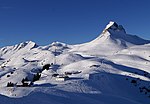
|
Vorarlberg | 1994 | iv, v (cultural) | The area has largely maintained its traditional farming structure including the specific types of farmstead buildings, with villages dating to 18th and 19th centuries. Small textile processing workshops bear testimony to early onset of industrial development in the region.[22] |
| Cathedral of Gurk | 
|
Gurk | 1994 | i, iii, iv (cultural) | The former cathedral church of Gurk, dating back to the 12th century, is one of the most significant examples of Romanesque churches in Austria. Notable features of the church are the "hundred-pillar" crypt, the burial place of the founder, Saint Hemma of Gurk, and a rich collection of frescoes.[23] |
| Hochosterwitz Castle | 
|
Carinthia | 1994 | i, iii, iv (cultural) | The castle, one of the most imposing medieval castles in Austria, is located on a high rock above a plain. The access to the castle is guarded by 14 fortified gates. Today's structure dates to the 16th century.[24] |
| Heiligenkreuz Abbey | 
|
Heiligenkreuz | 1994 | i, ii, iii, iv (cultural) | Heiligenkreuz abbey is a Cistercian monastery that was founded in the 12th century. The medieval parts of the complex are preserved and still used for original purposes today, while later extensions were built in the Baroque style.[25] |
| Iron Trail with Erzberg and the old town of Steyr | 
|
Upper Austria | 2002 | i, ii, iii, iv (cultural) | The Erzberg region, between the towns of Leoben and Hieflau in Styria, is home to large deposits of iron ore. The open pit mining has transformed the mountainsides, while the area features several facilities connected to iron smelting and trading activities. The old town of Steyr is one of the most significant historic industrial towns in Austria, situated at a confluence of two rivers which both powered the iron industry and provided transportation routes.[26] |
| Cultural Landscape of "Innsbruck-Nordkette/Karwendel" | 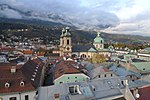
|
Tyrol | 2002 | i, ii, iii, iv (cultural) | The city of Innsbruck was founded at the junction of several important trade routes and served as the residence of dukes, kings, and emperors since the Late Middle Ages. Some of the important landmarks include the Goldenes Dachl (Golden Roof) and the Court Church that houses the cenotaph of Maximilian I. The city is located immediately underneath the Nordkette mountains, part of the Karwendel range, which are important for their Alpine pastures and as a tourist destination.[27] |
| National Park "Hohe Tauern" | 
|
Carinthia, Salzburg, Tyrol | 2003 | vii, viii, ix, x (natural) | The national park is home to endemic Alpine animal and plant species, while also bearing witness to geomorphological processes shaping the mountains. Part of the park is covered by glaciers. Mountain passes in the area have been important since the 2nd millennium BCE while the Grossglockner High Alpine Road, constructed in the 1930s, is an important pioneering achievement.[28] |
| Hall in Tyrol – The Mint | 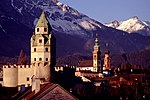
|
Hall in Tyrol | 2013 | i, ii, iv (cultural) | The town of Hall was first mentioned in the 13th century. It rose to prominence when the Archduke Sigmund of Tyrol transferred the Tyrolian mint from Meran to Hall in 1477. The mint produced high-quality silver coins, called thalers, and also introduced several technological innovations, such as the roller-press coinage that replaced minting by hammer. The historic centre in late Gothic style, which remained to an extraordinary high extent intact, represents an example of medieval town-planning and urban development.[29] |
| Great Spas of Europe (Austria)* | 
|
Bad Ischl, Baden bei Wien | 2014 | ii, iii, iv, vi (cultural) | Great Spas of Europe cover sites where mineral waters were used for healing and therapeutic purposes before the development of industrial medication in the 19th century. Two spas are listed in Austria, Baden bei Wien and Bad Ischl.[30] |
| Frontiers of the Roman Empire (Austria)* | 
|
Lower Austria, Upper Austria, Vienna | 2015 | ii, iii, iv (cultural) | The Danubian Limes, a network of fortifications along the Danube river, protected the borders of the Roman Empire. The Austrian section is 357.5 km (222.1 mi) long and includes 21 locations on the tentative list. The Salz Tower (Salzturm) in Tulln is pictured.[31] |
| Großglockner High Alpine Road / Großglockner Hochalpenstraße | 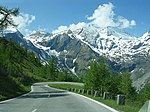
|
Carinthia, Salzburg | 2016 | i, ii, iv (cultural) | The road was built in the 1930s into a pristine mountain landscape to make it accessible to a large public, following the popularisation of tourism in the High Alpine region. It showcases the technical development of high mountain road building and the management of tourism sites in the early 20th century.[32] |
Notes
[編集]- ^ The site Prehistoric pile dwellings around the Alps consists of 111 separate sites spread over six countries. The dot in the map indicates the Attersee which is home to three of Austria's five UNESCO pile dwellings.
- ^ The site Ancient and Primeval Beech Forests of the Carpathians and Other Regions of Europe consists of 78 separate sites spread over twelve countries. The dot in the map indicates "Kalkalpen – Hintergebirg" which is the largest of Austria's five UNESCO beech forests.
References
[編集]- ^ “The World Heritage Convention”. UNESCO World Heritage Centre. 27 August 2016時点のオリジナルよりアーカイブ。7 July 2019閲覧。
- ^ a b “Austria – Properties inscribed on the World Heritage List”. UNESCO World Heritage Centre. 24 October 2005時点のオリジナルよりアーカイブ。7 July 2019閲覧。
- ^ “Report of the Rapporteur”. UNESCO World Heritage Centre (March 10, 1997). May 11, 2002時点のオリジナルよりアーカイブ。July 12, 2014閲覧。
- ^ a b “Historic Centre of Vienna inscribed on List of World Heritage in Danger”. UNESCO World Heritage Centre. 8 July 2017時点のオリジナルよりアーカイブ。6 July 2017閲覧。
- ^ “UNESCO World Heritage Centre – The Criteria for Selection”. UNESCO World Heritage Centre. 12 June 2016時点のオリジナルよりアーカイブ。17 August 2018閲覧。
- ^ “Historic Centre of the City of Salzburg”. UNESCO World Heritage Centre. 4 November 2005時点のオリジナルよりアーカイブ。7 July 2019閲覧。
- ^ “UNESCO World Heritage List : This is Salzburg”. salzburg.info. 6 June 2017時点のオリジナルよりアーカイブ。7 July 2019閲覧。
- ^ “Palace and Gardens of Schönbrunn”. UNESCO World Heritage Centre. 22 July 2005時点のオリジナルよりアーカイブ。7 July 2019閲覧。
- ^ “Hallstatt-Dachstein / Salzkammergut Cultural Landscape”. UNESCO World Heritage Centre. 1 December 2005時点のオリジナルよりアーカイブ。7 July 2019閲覧。
- ^ “Semmering railway”. UNESCO World Heritage Centre. 27 November 2005時点のオリジナルよりアーカイブ。7 July 2019閲覧。
- ^ “City of Graz – Historic Centre and Schloss Eggenberg”. UNESCO World Heritage Centre. 19 November 2005時点のオリジナルよりアーカイブ。7 July 2019閲覧。
- ^ “Wachau Cultural Landscape”. UNESCO World Heritage Centre. 8 December 2005時点のオリジナルよりアーカイブ。7 July 2019閲覧。
- ^ “Fertö / Neusiedlersee Cultural Landscape”. UNESCO World Heritage Centre. 10 November 2011時点のオリジナルよりアーカイブ。7 July 2019閲覧。
- ^ “Historic Centre of Vienna”. UNESCO World Heritage Centre. 1 December 2005時点のオリジナルよりアーカイブ。7 November 2011閲覧。
- ^ “Unesco puts Vienna's historic centre on 'in danger' list – The Local”. Thelocal.at. 19 October 2018時点のオリジナルよりアーカイブ。7 July 2019閲覧。
- ^ “Prehistoric Pile Dwellings around the Alps – Maps”. UNESCO World Heritage Centre. 3 October 2020時点のオリジナルよりアーカイブ。7 July 2019閲覧。
- ^ “Prehistoric Pile dwellings around the Alps”. UNESCO World Heritage Centre. 26 February 2012時点のオリジナルよりアーカイブ。14 February 2012閲覧。
- ^ “Ancient and Primeval Beech Forests of the Carpathians and Other Regions of Europe”. UNESCO World Heritage Centre. 2 March 2012時点のオリジナルよりアーカイブ。7 September 2017閲覧。
- ^ “Tentative Lists”. UNESCO. April 1, 2016時点のオリジナルよりアーカイブ。July 12, 2014閲覧。
- ^ “UNESCO World Heritage Centre – Tentative Lists”. UNESCO World Heritage Centre. 3 October 2020時点のオリジナルよりアーカイブ。7 July 2019閲覧。
- ^ “Abbey of Kremsmünster”. UNESCO World Heritage Centre. 3 October 2020時点のオリジナルよりアーカイブ。7 July 2019閲覧。
- ^ “Bregenzerwald (Bregenz Forest)”. UNESCO World Heritage Centre. 11 June 2007時点のオリジナルよりアーカイブ。7 July 2019閲覧。
- ^ “Cathedral of Gurk”. UNESCO World Heritage Centre. 3 October 2020時点のオリジナルよりアーカイブ。7 July 2019閲覧。
- ^ “Hochosterwitz Castle”. UNESCO World Heritage Centre. 3 October 2020時点のオリジナルよりアーカイブ。7 July 2019閲覧。
- ^ “Heiligenkreuz Abbey”. UNESCO World Heritage Centre. 3 October 2020時点のオリジナルよりアーカイブ。7 July 2019閲覧。
- ^ “Iron Trail with Erzberg and the old town of Steyr”. UNESCO World Heritage Centre. 3 October 2020時点のオリジナルよりアーカイブ。7 July 2019閲覧。
- ^ “Cultural Landscape of "Innsbruck-Nordkette/Karwendel"”. UNESCO World Heritage Centre. 3 October 2020時点のオリジナルよりアーカイブ。7 July 2019閲覧。
- ^ “National Park "Hohe Tauern"”. UNESCO World Heritage Centre. 3 October 2020時点のオリジナルよりアーカイブ。7 July 2019閲覧。
- ^ “Hall in Tyrol – The Mint”. UNESCO World Heritage Centre. 3 October 2020時点のオリジナルよりアーカイブ。7 July 2019閲覧。
- ^ “Great Spas of Europe (Austria)”. UNESCO World Heritage Centre. 3 October 2020時点のオリジナルよりアーカイブ。7 July 2019閲覧。
- ^ “Frontiers of the Roman Empire (Austria) - UNESCO World Heritage Centre”. UNESCO World Heritage Centre. 3 October 2020時点のオリジナルよりアーカイブ。7 July 2019閲覧。
- ^ “Großglockner High Alpine Road / Großglockner Hochalpenstraße”. UNESCO World Heritage Centre. 3 October 2020時点のオリジナルよりアーカイブ。7 July 2019閲覧。
External links
[編集]Template:Austria topics Template:World Heritage Sites in Austria Template:Lists of World Heritage Sites in Europe

